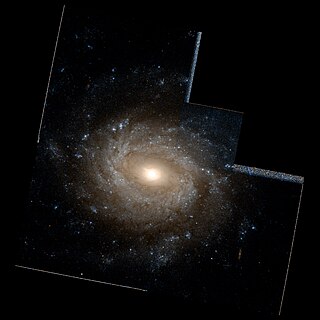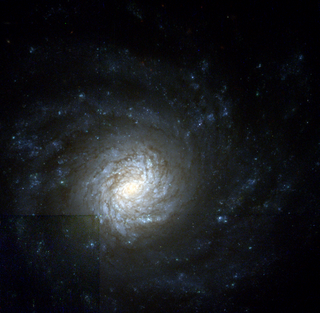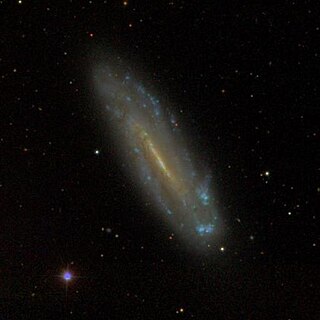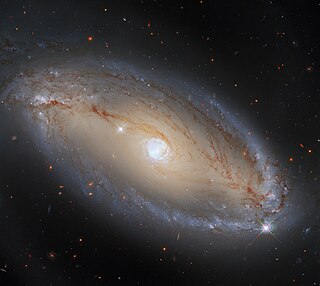
An intermediate-mass black hole (IMBH) is a class of black hole with mass in the range 102–105 solar masses: significantly more than stellar black holes but less than the 105–109 solar mass supermassive black holes. Several IMBH candidate objects have been discovered in our galaxy and others nearby, based on indirect gas cloud velocity and accretion disk spectra observations of various evidentiary strength.

Messier 105 or M105, also known as NGC 3379, is an elliptical galaxy 36.6 million light-years away in the equatorial constellation of Leo. It is the biggest elliptical galaxy in the Messier catalogue that is not in the Virgo cluster. It was discovered by Pierre Méchain in 1781, just a few days after he discovered the nearby galaxies Messier 95 and Messier 96. This galaxy is one of a few not object-verified by Messier so omitted in the editions of his Catalogue of his era. It was appended when Helen S. Hogg found a letter by Méchain locating and describing this object which matched those aspects under its first-published name, NGC 3379.

NGC 4395 is a nearby low surface brightness spiral galaxy located about 14 million light-years from Earth in the constellation Canes Venatici. The nucleus of NGC 4395 is active and the galaxy is classified as a Seyfert Type I known for its very low-mass supermassive black hole.

NGC 4725 is an intermediate barred spiral galaxy with a prominent ring structure, located in the northern constellation of Coma Berenices near the north galactic pole. It was discovered by German-born astronomer William Herschel on April 6, 1785. The galaxy lies at a distance of approximately 40 megalight-years from the Milky Way.

NGC 2787 is a barred lenticular galaxy approximately 24 million light-years away in the northern constellation of Ursa Major. It was discovered on December 3, 1788 by German-born astronomer William Herschel. J. L. E. Dreyer described it as, "bright, pretty large, a little extended 90°, much brighter middle, mottled but not resolved, very small (faint) star involved to the southeast". The visible galaxy has an angular size of 2.5 × 1.5 arcminutes or 3.24 × 1.81 arcminutes and an apparent visual magnitude of 11.8.

NGC 3227 is an intermediate spiral galaxy that is interacting with the dwarf elliptical galaxy NGC 3226. The two galaxies are one of several examples of a spiral with a dwarf elliptical companion that are listed in the Atlas of Peculiar Galaxies. Both galaxies may be found in the constellation Leo. It is a member of the NGC 3227 Group of galaxies, which is a member of the Leo II Groups, a series of galaxies and galaxy clusters strung out from the right edge of the Virgo Supercluster.

NGC 3486 is an intermediate barred spiral galaxy located about 27.4 million light years away in the constellation of Leo Minor. It has a morphological classification of SAB(r)c, which indicates it is a weakly barred spiral with an inner ring and loosely wound arms. This is a borderline, low-luminosity Seyfert galaxy with an active nucleus. However, no radio or X-ray emission has been detected from the core, and it may only have a small supermassive black hole with less than a million times the mass of the Sun.

An ultraluminous X-ray source (ULX) is an astronomical source of X-rays that is less luminous than an active galactic nucleus but is more consistently luminous than any known stellar process (over 1039 erg/s, or 1032 watts), assuming that it radiates isotropically (the same in all directions). Typically there is about one ULX per galaxy in galaxies which host them, but some galaxies contain many. The Milky Way has not been shown to contain a ULX, although SS 433 may be a possible source. The main interest in ULXs stems from their luminosity exceeding the Eddington luminosity of neutron stars and even stellar black holes. It is not known what powers ULXs; models include beamed emission of stellar mass objects, accreting intermediate-mass black holes, and super-Eddington emission.

NGC 4536 is an intermediate spiral galaxy in the constellation Virgo located about 10° south of the midpoint of the Virgo cluster. However, it is not considered a member of the cluster. Rather, it is a member of the M61 Group of galaxies, which is a member of the Virgo II Groups, a series of galaxies and galaxy clusters strung out from the southern edge of the Virgo Supercluster. The morphological classification in the De Vaucouleurs system is SAB(rs)bc, which indicates it is a weakly barred spiral galaxy with a hint of an inner ring structure plus moderate to loosely wound arms. It does not have a classical bulge around the nucleus.

NGC 1023 is a barred lenticular galaxy, a member of the NGC 1023 group of galaxies in the Local Supercluster. Distance measurements vary from 9.3 to 19.7 million parsecs (30 to 64 million light-years). The supermassive black hole at the core has a mass of (4.4±0.5)×107 M☉. The black hole was discovered by analyzing the dynamics of the galaxy.

NGC 3783 is a barred spiral galaxy located about 135 million light years away in the constellation Centaurus. It is inclined by an angle of 23° to the line of sight from the Earth along a position angle of about 163°. The morphological classification of SBa indicates a bar structure across the center (B) and tightly-wound spiral arms (a). Although not shown by this classification, observers note the galaxy has a luminous inner ring surrounding the bar structure. The bright compact nucleus is active and categorized as a Seyfert 1 type. This nucleus is a strong source of X-ray emission and undergoes variations in emission across the electromagnetic spectrum.

NGC 4698 is a barred spiral galaxy located around 55 million light years away from Earth in the constellation of Virgo. It belongs to the Virgo Cluster of galaxies and is positioned near the northeastern edge of this assemblage. The morphological classification of NGC 4698 in the De Vaucouleurs system is SA(s)ab, which indicates a purely spiral structure with moderate to tightly wound arms. It is inclined to the line of sight from the Earth by an angle of 53° along a position angle of 170°.

NGC 4102 is an intermediate barred spiral galaxy located in the northern constellation of Ursa Major. It is visible in a small telescope and has an apparent visual magnitude of 11.2. The galaxy was discovered April 12, 1789 by William Herschel. J. L. E. Dreyer described it as "bright, pretty small, round, brighter middle and bright nucleus". This galaxy is located at a distance of 60 million light years and is receding with a heliocentric radial velocity of 837 km/s. It is a member of the Ursa Major group of galaxies.

NGC 2748 is a spiral galaxy in the northern circumpolar constellation of Camelopardalis, located at a distance of 61.3 megalight-years from the Milky Way. It was discovered September 2, 1828 by John Herschel. The morphological classification of SAbc indicates this is an unbarred spiral with moderate to loosely-wound spiral arms. It is a disk-like peculiar galaxy with a stellar shell that is rotating about the main galactic axis. This shell was most likely formed through the capture and disruption of a dwarf companion. The galactic nucleus likely contains a supermassive black hole with a mass of 4.4+3.5
−3.6×107 M☉, or 44 million times the mass of the Sun.

NGC 4041 is the New General Catalogue identifier for a spiral galaxy in the northern circumpolar constellation of Ursa Major. It is located an estimated 70 million light years from the Sun. The morphological classification of SA(rs)bc indicates this is a spiral galaxy the lacks a bar; the 'rs' means it has a weakly-formed ring structure, and the 'bc' indicates the spiral arms are moderately to loosely wound.

NGC 4178 is the New General Catalogue identifier for a barred spiral galaxy in the equatorial constellation of Virgo. It was discovered April 11, 1825 by English astronomer John Herschel. Located some 43.8 million light years away, this galaxy spans 2.3 × 0.4 arc minutes and is seen at a low angle, being inclined by 77° to the line of sight from the Earth. The morphological classification of NGC 4178 is SB(rs)dm, indicating that it has a bar feature at the core, and, per the '(rs)', has traces of a ring-like structure surrounding the bar. The 'dm' suffix indicates the spiral arms are diffuse, broken, and irregular in appearance with no bulge at the nucleus. This galaxy is a member of the Virgo Cluster, which is the richest nearby group of galaxies outside the Local Group and forms the core of the Virgo Supercluster.

NGC 3367 is a barred spiral galaxy located in the constellation Leo. It is located at a distance of about 120 million light years from Earth, which, given its apparent dimensions, means that NGC 3367 is about 85,000 light years across. It was discovered by William Herschel on March 19, 1784.

NGC 5728 is an active barred spiral galaxy located 146 million light years away in the southern constellation of Libra. It was discovered on May 7, 1787 by William Herschel. The designation comes from the New General Catalogue of J. L. E. Dreyer, published in 1888. It has an apparent visual magnitude of 13.40 and spans an angle of 3.4 arcminutes. The galaxy shows a red shift of 0.00935 and has a heliocentric radial velocity of 2,803 km/s. It has an estimated mass of 72 billion times the mass of the Sun and stretches around 30 kpc across.



















